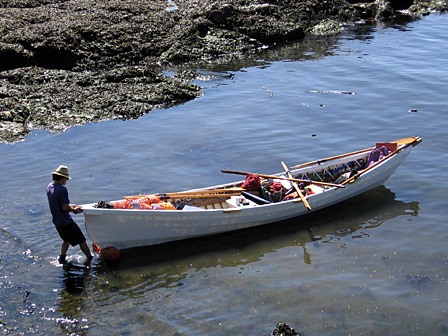It’s a simple boat that will be built by the hands of Orcas youth.
With the help of a $10,000 Toyota Tapestry grant, Brett McFarland’s Orcas High School applied physics class will be designing, constructing, and eventually captaining a 21-foot “umiak” wooden boat next school year.
“It’s the open boat version of a kayak,” McFarland said. “It’s a traditional Inuit boat. It’s the simple way to build a boat.”
Umiaks were traditionally built in the arctic regions of North America and their design reflects the scarcity of wood available in these areas – the crafts were created with a skeleton of small sticks all lashed together and then “skinned” with animal hides.
What is not traditional about the Orcas project is the energy-saving, solar electric propulsion system that the students will engineer and construct. It will include monitoring hardware that allows students to record energy consumption as well as input from the sun. Rainshadow Solar and Waldron Power and Light will be assisting the class with installing photovoltaic charging, multiple battery chemistries, and monitoring hardware.
“The kids will be doing applied physics, engineering, and a huge electrical component,” McFarland said. “The class will give the kids a way to assess human power versus electrical power.”
McFarland wrote the grant without much hope it would be awarded to a school of Orcas Island’s size. But his hard work paid off. Orcas was one of only 10 schools in the country to receive the grant, which had several requirements: the project needed to be an interesting way to teach science, incorporate alternative energy, and involve the community.
“It’s a huge grant,” he said. “I always thought it would be fun to apply, but it’s a ridiculous amount of paperwork. But I filled it all out … it’s a little surprising they gave it to us.”
McFarland, who has built a rowboat and a few kayaks himself, taught a similar class in 2004 with five eighth grade students. The kids built the boat’s frame during the twice-a-week elective class, and McFarland finished the watercraft on his own time. His wife Jill Sherman also helped with the course.
“We saw what it would be like to build a boat as a class,” he said. “(For this project) to keep the whole class busy you really have to break it down.”
The first half of the year will be spent building the boat’s frame and covering it in nylon. Then the students will work on the electrical system and run sea trials in Eastsound. The project will culminate in a camping trip on Sucia or Patos.
Although the class is only open to 20 high school students (10th grade and up), some younger kids will be included. The high schoolers will give mini-presentations to the fifth-grade class at least once a month. All students will keep a journal, which will include notes and sketches of the year’s progress.
Computer teacher Paul Evans is partnering with McFarland on the course. He will teach the kids how to use the school’s video equipment, so they can document each stage of the construction. The film, along with a class presentation, will be shown to the community at the end of the school year.
“Living on an island is the perfect excuse to build a boat,” McFarland said. “This area has a long-standing tradition of boat-building.”



